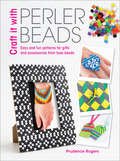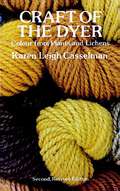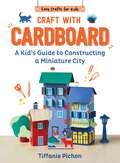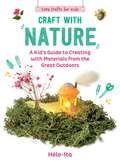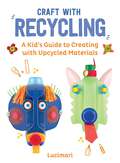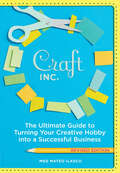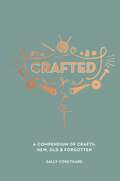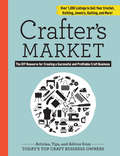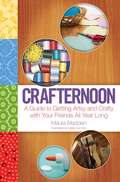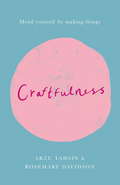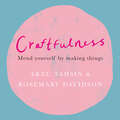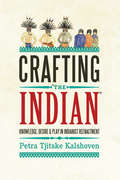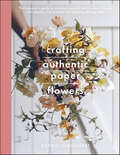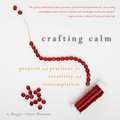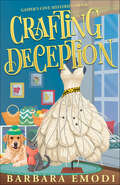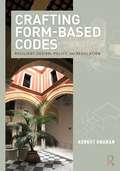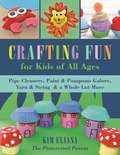- Table View
- List View
Craft it With Hama Beads
by Prudence RogersGet fired up by fuse beads with this stunning collection of simple makes!A new wave of crafters are turning Hama Beads on their head and showing that far from being just novelties for kids, these colourful plastic beads that fuse together when ironed can be used to make stunning sophisticated gifts and accessories.In this fun collection of genuinely easy makes, you will find fuse bead patterns, designs and ideas for a wide range of items - from jewellery such as necklaces, earrings, bracelets and rings, to home décor items such as coasters, a photo frame, a garland, a clock and even a lampshade that will have you seeing Hama Beads in a whole new light!Each project has a full-colour chart plus easy-to-follow instructions to guide you through the process from start to finish.
Craft it With Perler Beads
by Prudence RogersGet fired up by fuse beads with this stunning collection of simple makes!A new wave of crafters are turning Perler Beads on their head and showing that far from being just novelties for kids, these colourful plastic beads that fuse together when ironed can be used to make stunning sophisticated gifts and accessories.In this fun collection of genuinely easy makes, you will find fuse bead patterns, designs and ideas for a wide range of items - from jewellery such as necklaces, earrings, bracelets and rings, to home décor items such as coasters, a photo frame, a garland, a clock and even a lampshade that will have you seeing Perler Beads in a whole new light!Each project has a full-colour chart plus easy-to-follow instructions to guide you through the process from start to finish.
Craft of Use: Post-Growth Fashion
by Kate FletcherThis book explores the ‘craft of use’, the cultivated, ordinary and ingenious ideas and practices that promote satisfying and resourceful use of garments, presenting them as an alternative, dynamic, experiential frame with which to articulate and foster sustainability in the fashion sector. Here Kate Fletcher provides a broad imagining of sustainability in fashion that gives attention to tending and wearing garments, and favours their use as much as their creation. She offers a diversified view of fashion beyond the market and the market’s purpose and reveals fashion provision and expression in a world not dependent on continuous consumption. Framing design and use as a single whole, the book uncovers a more contingent and time-dependent role for design in sustainability, recognising that garments, while sold as a product, are lived as a process. Drawing from stories and portrait photography that document the ways in which members of the public from across three continents use their clothes, and the work of seven international design teams seeking to amplify these use practices, Craft of Use presents a changed social narrative for fashion, borne out of ideas of satisfaction and interdependence, of action, knowledge and human agency, that glimpses fashion post-growth.
Craft of the Dyer: Colour from Plants and Lichens
by Karen Leigh CasselmanCraftspeople interested in traditional methods will welcome this complete guide to making and using dyes from plants. Although its emphasis is on plants of Northeastern North America, many of the plants listed are found throughout the world.Helpful introductory chapters on equipment, mordants, dyeing procedures and other essentials, are followed by individual plants: its suitability for dyeing, useful parts, how to process them, colors, dye fastness, plant identification, where to find it, and more. Also include four valuable indexes -- plants by common name, botanical name, by colors produced, and a general index. A list of suppliers, metric conversion tables and other information rounds out this thorough guide to safe, ecologically sound dyeing methods.
Craft the Rainbow: 40 Colorful Paper Projects from The House That Lars Built
by Brittany Watson JepsenThe popular craft designer and lifestyle blogger shares a rainbow of new project ideas—all using the creative power of paper.What began as a project collection and viral Instagram hashtag (#CrafttheRainbow) has become an inspiring book featuring all-new paper project ideas. Learn how to make playful party decorations, luscious flowers, amazing cards, and sophisticated wreaths, garlands, centerpieces, and more than you can imagine. Brittany Watson Jepsen is known for the unusually imaginative and amazingly beautiful designs she creates for her website and host of clients (including Anthropologie). In Craft the Rainbow, Jepsen walks readers through the easy basics of transforming simple paper—including tissue, crepe, cardstock, leaves of books, and vintage and recycled paper—into vibrant, fanciful, handmade projects suitable for every occasion.
Craft with Cardboard: A Kid's Guide to Constructing a Miniature City (Easy Crafts for Kids)
by Tiffanie PichonPut yourself in the shoes of a real architect and create your very own city out of cardboard! In this guided collection, young crafters and artists will find step-by-step instructions and full-color photographs that will aid them in creating a whole city (people and vehicles included!) out of cardboard. Author and artist Tiffanie Pichon opens with encouraging words that will inspire crafters to pay closer attention to their surroundings as they move through their city or town. The architecture—from roof to window—the sidewalks, parks, and even the jobs people are doing while they walk or drive through a city may inspire their creations as they construct their very own city out of recycled materials, like cardboard. The projects featured throughout this fully illustrated book will come together to create a neighborhood, but may also inspire future projects such as DIY rural towns and farms. Types of creations include houses and stores, towers and skyscrapers, factories, people and animals, vehicles, mountains, trees, benches, and more—all requiring the most basic supplies (tape or glue, scissors, paints or markers, rulers, colored paper, egg cartons, etc.) and whatever recycled or natural materials the crafter wants to use!
Craft with Nature: A Kid's Guide to Creating with Materials from the Great Outdoors (Easy Crafts for Kids #1)
by Héloïse Charier-MaurelEnter the world of an artist with a natural spirit in this collection of crafts inspired by your surroundings! In this guided collection, young crafters and artists will find step-by-step instructions and full-color photographs that will aid them in creating decorations and playful projects using elements of the natural world. Author and artist Hélo-Ita opens with encouraging words that will inspire crafters to pay closer attention to the environment and all it has to offer when outdoors, whether they&’re on a serene hiking path in a forest, dipping into the waves at the beach, or simply playing in their own background or walking to school. You never know which materials you may find! The projects featured throughout this fully-illustrated book can be created as displayed on the page and may inspire future crafts. Types of creations include greeting cards, sculptures, light displays, kawaii rock pets, mobiles, ships in bottles, and tea light villages—all requiring the most basic supplies (tape or glue, scissors, paints or pens, thread) and whatever natural materials you source!
Craft with Recycling: A Kid's Guide to Creating with Upcycled Materials (Easy Crafts for Kids #2)
by Stéphanie BoulayIn this guided collection, young crafters and artists will find step-by-step instructions and full-color photographs that will aid them in creating decorations and playful projects using elements they have designated for reuse or upcycling. Author and artist Stéphanie Boulay, known as Lucimari, opens with encouraging words that will inspire crafters to pay closer attention to their surroundings for materials that may otherwise be thrown away, such as cans, bottles, scraps of paper or felt, unused and mismatched yarn. You never know which materials may be given a second life! The projects featured throughout this fully illustrated book can be created as displayed on the page and may inspire future crafts. Types of creations include masks, figurines or toys, mobiles, desk organizers, and more.
Craft, Inc.: The Ultimate Guide to Turning Your Creative Hobby into a Successful Business
by Meg Mateo IlascoThis revised and expanded edition of the definitive crafter’s business book covers everything from product development to social media marketing.Crafters looking to turn their hobby into a profession can rely on the tried and true advice in Craft, Inc. An author, entrepreneur, and multidisciplinary creative, Meg Mateo Ilasco offers guidance on everything from developing products and sourcing materials to writing a business plan and paying taxes. With all-new sections on opening an online shop, using social media strategically, and more—along with updated interviews from such craft luminaries as Jonathan Adler and Jill Bliss—this comprehensive primer features the most current information on starting and running a successful creative business.
CraftFail: When Homemade Goes Terribly Wrong
by Heather MannPoor Bridgit, who overestimated the size of her head—her homemade frilly lace shower cap came straight down to her chin. And who can blame Lindsey for thinking “glitter shoes” sounded like a cool, easy project instead of what it turned out to be: a puddle of sparkling glop. And really, whoever posted that incredible Spaghetti-Stuffed Garlic Bread on Pinterest should be sued. When Mindy pulled hers from the oven, it looked like a “hot mess of intestines streaming out of doughy flesh.” Mmmm, thank you, Pinterest! Written by Heather Mann, publisher of CraftFail.com, her hilarious blog with millions of page views and hundreds of thousands of followers, CraftFail celebrates the creative process, but from the other side. This is the stuff that gets the “A for Effort” and LOL for outcome. But once the laughter dies down, it also inspires a warm feel-good respect for crafters who aren’t afraid to fail. After all, even if there’s not a mortal alive except Martha who can make a Waxed Heart worthy of hanging in your window to catch the sun, why shouldn’t many try? When it goes wrong, why shouldn’t the rest of us enjoy this Epic Fail? And then look at all the full-color photos that document it. Home decor fails, fashion fails, holiday fails, food fails, kid crafting fails— as one anonymous crafter said: “It wasn’t supposed to end this way.” Luckily for us, it did.
Crafted Kinship: Inside the Creative Practices of Contemporary Black Caribbean Makers
by Malene BarnettA visual journey of Caribbean art profiling more than 60 contemporary Caribbean artists, curated by award winning multidisciplinary artist and textile surface designer, Malene Barnett. Through powerful interviews with more than 60 artists and designers of Caribbean heritage, accompanied by gorgeous photographs, Crafted Kinship takes readers on a unique journey through the world of Black Caribbean creativity. Each maker crafts a kinship with the land, the people, the culture of their country of origin. Their art explores and reflects deeply on themes like African origins, ancestors, Black womanhood/Black manhood, identity, joy, memory, and the complicated and painful history of migration and diaspora. An art that is more often than not multidisciplinary, created by makers who eschew traditional labels by reshaping the boundaries around art and design. Curated by Malene Barnett, an award-winning multidisciplinary artist and textile surface designer of Jamaican and Vincentian descent, Crafted Kinship is the first book in which Caribbean makers share the intimate stories of their art-making process and how their countries of origin influence and inform how and what they create. Included are makers working across all mediums. Meet Anina Major, a Bahamian visual artist whose work attempts to reclaim the significance of straw basketry through her ceramics; Basil Watson, a Jamaican figurative artist and sculptor famous for his stunning bronze figures that are exhibited outdoors all over the world; Renee Cox, a Jamaican photographer whose work celebrates Black womanhood; La Vaughn Belle, a multidisciplinary artist from St. Croix who draws from archival sources to interrogate colonial legacies; Sonya Clark, a textile artist and educator of Jamaican, Trinidadian, and Bajan heritage who works with hair and other meaningful materials to explore issues of power, race, and gender; and Nyugen E. Smith, an interdisciplinary artist of Trinidadian and Haitian ancestry whose fluid stream of consciousness is expressed through objects, performance, music, and moving image.
Crafted: A Compendium of Crafts: New, Old and Forgotten
by Sally CoulthardCrafted is a celebration of craft in the 21st century – a definitive visual guide to all things handmade.Featuring over 73 of the most popular and well-established crafts, Sally Coulthard explores their history, materials and techniques as she offers a deeper insight into some of your favourite crafts and provides inspiration for both new and ancient creative pursuits.After an introductory section covering the culture of craft (its definition, why it matters, history and community), the main body of the book consists of beautifully illustrated entries on 73 of the world's most established crafts. The scope is encyclopaedic and covers Paper, Pen & Print (bookbinding, origami, calligraphy, lino printing), Textiles, Cloth & Leather (fur & leather, embroidery, knitting, dyeing), Pottery, Glass & Stone (porcelain, stained glass, stone carving), Wood, Willow & Nature (basket weaving, wood carving, lime plastering and thatching) and Metal (gold, bronze, cast iron and steel).A comprehensive directory of craft organisations and professional communities and guilds, completes this groundbreaking compendium.
Crafter's Market: The DIY Resource for Creating a Successful and Profitable Craft Business (Market)
by Abigail Patner GlassenbergTurn Your Crafting Into a Career! All over the world, creatives are turning their hobby into their livelihoods--and Crafter's Market offers the competitive edge you need to make your craft your career. This comprehensive guide will introduce you to a new world of possibilities for taking your craft to the next level. To help you on your journey, this edition is updated with fresh resources, such as:Over 250 new listings for complete, up-to-date contacts and submission guidelines for more than 1,500 craft market resources, including craft shows, publishers, marketplaces, and more!Informative, inspirational articles on building your brand, customer communication, teaching classes, getting press coverage, photographing your goods, and more, from successful craft business owners.Actions you can take today to grow your business now, no matter your creative medium--quilting, sewing, knitting, crochet, papercraft, or jewelry making!Whether you're looking to expand your online presence or you're just beginning to think about how to turn your weekend hobby into a side business, Crafter's Market is the complete resource for creative professionals.
Crafternoon
by Maura MaddenHello, Crafternooners! Maura Madden invites you to enjoy a fun-filled afternoon of crafting.... Named after a monthly event that comedian and crafting superstar Maura Madden began hosting in 2002 as a way to get her friends together, meet new people, and have a good time making some cool stuff, Crafternoon is both an entertaining how-to guide and an irreverent social manifesto. Organized by month and theme, Crafternoon explains how to create and host a fun-filled casual gathering (including recipes for snacks and decorating tips) that celebrates the art of crafting. Knot nautical-themed crafts to wear, quilt new additions to your home decor, make the perfect gift for any holiday, or feel free to BYOP (bring your own project). All crafters are always welcome and encouraged to bring guests, and if your knitting or clay-shaping skills are a bit rusty, that's fine, too -- there are instructions aplenty! A must-have for anyone who wants to get their craft on, this quirky guide offers a twelve-month blueprint for a year of connecting with friends old and new, and enjoying a possibly messy, but always fulfilling afternoon.
Craftfulness
by Rosemary Davidson Arzu Tahsin'Making things can mend your mind' - Telegraph'Chicken soup for the crafter's soul' - Publisher's Weekly_______What is that unique feeling that goes hand-in-hand with making something from scratch? Do you ever wonder where the time goes when you're lost in drawing or working with clay? Are you happiest when you're sewing or knitting?Craft enthusiasts are no doubt already aware of the joys of making and the frustration when you must put aside your project and go back to your day job or to less enticing tasks around the house. But there is more to crafting than the simple enjoyment of a creative hobby.Drawing on the first-hand accounts from everyday crafters, Craftfulness considers the vital well-being effects to be gained from the simple expression of your creativity, and investigates the soul-cleansing and stress-relieving benefits of making things by hand. An all-you-need-to-know friendly guide to inspire you to give making a go, Craftfulness:- explores the science of creativity and the authors' down-to-earth craft ethos, as well as why everyone should develop a craft habit; - suggests ways to make time in a hectic life for everyday creative work- considers how we can try to overcome self-criticism and lack of confidence- features simple but immensely satisfying craft projects to still the mind and soothe the soul, complete with beautifully illustrated step-by-step instructionsTo read Craftfulness is the first step on the path to leading a happier, healthier, more satisfying and fulfilling life.
Craftfulness
by Rosemary Davidson Arzu TahsinWhat is that unique feeling that goes hand-in-hand with making something from scratch? Do you ever wonder where the time goes when you're lost in drawing or working with clay ?Are you happiest when you're sewing or knitting? Craft enthusiasts are no doubt already aware of the joys of making and the frustration when you must put aside your project and go back to your day job or to less enticing tasks around the house. But there is more to crafting than the simple enjoyment of a creative hobby.Drawing on the first-hand accounts from everyday crafters, Craftfulness considers the vital well-being effects to be gained from the simple expression of your creativity, and investigates the soul cleansing and stress-relieving benefits of making things by hand.
Craftfulness: Mend Yourself by Making Things
by Rosemary DavidsonIntegrating mindfulness, neuroscience, positive psychology, and creativity research, Craftfulness offers a thought-provoking and surprising reconsideration of craft, and how making things with our hands can connect us to our deepest selves and improve our well-being and overall happiness.We should get this out of the way: Craftfulness is not a crafting book. Rather, it is an investigation of the wisdom generations of men and women know to be true: making things is a vital means of self-expression, self-realization, and self-help that sparks the mind, touches the soul, and rejuvenates the spirit.Process, not product, is the soul of craft practice. Whether you knit, crochet, sculpt, weave, quilt, tat, draw, or bind books, working toward small, attainable goals gives us a sense of purpose, accomplishment, and control that is proven to positively impact our mental health and happiness.In Craftfulness, Rosemary Davidson and Arzu Tahsin offer a brilliantly reasoned argument in favor of craft and its positive impact on our mental well-being. Weaving personal experiences with the latest science on mindfulness, happiness, and creativity, they illuminate how craft practice reintroduces balance into our lives and habits by cultivating creativity, promoting focus, creating a safe environment for failure, and encouraging us to make peace with imperfection.Like Matthew B. Crawford’s Shop Class as Soulcraft, Ken Robinson’s Out of Our Minds, and Mihaly Csikszentmihalyi’s Flow, Craftfulness helps us to see our world in a new way, offering opportunities to disconnect and pay attention to ourselves.
Crafting 'the Indian'
by Petra Tjitske KalshovenIn Europe, Indian hobbyism, or Indianism, has developed out of a strong fascination with Native American life in the 18th and 19th centuries. "Indian hobbyists" dress in homemade replicas of clothing, craft museum-quality replicas of artifacts, meet in fields dotted with tepees and reenact aspects of North American Indian lifeworlds, using ethnographies, travel diaries, and museum collections as resources. Grounded in fieldwork set among networks of Indian hobbyists in Germany, the Netherlands, Belgium, France, and the Czech Republic, this ethnography analyzes this contemporary practice of serious leisure with respect to the general human desire for play, metaphor, and allusion. It provides insights into the increasing popularity of reenactment practices as they relate to a deeper understanding of human perception, imagination, and creativity.
Crafting Authentic Paper Flowers (Crafts Ser.)
by Sophie Longhurst"Exquisite full-page color photos showcase the intricate projects, and the step-by-step instructions are accompanied with photographs. This master class will entice crafters both seasoned and new." -Publishers WeeklyThe delicate art of paper flower craft has been around for centuries, originating in China in 100BC. Since then, the art has remained a powerful tool in calming the mind and encouraging a slower pace of life. Whatever your background, lifestyle or commitments, this book contains projects to nurture your personal skill set. Step-by-step instructions and inspiring illustrations will guide you through the process from start to finish. Paper crafting is an accessible hobby that can be easily practised at home by everyone of all ages. Whether you’re looking for a rewarding activity to share with your children, or something to help you unwind after a long workday, paper flower crafting is a perfect choice. Use your newfound skills to create your own decorations for display or pleasure, and discover the wonder of nature in all its glorious detail by paying special attention to the coloring, textures and intricate details of your projects.
Crafting Calm
by Mary Anne Radmacher M.A. Maggie Oman ShannonAs our world has become increasingly dependent on technology, and our Western societies have become woefully "Crackberried"- to use the title of a recent documentary on the emotional and social pitfalls of our too-wired ways-an intriguing phenomenon is occurring: There is an increasing amount of interest in returning to some of the simpler arts that were neglected or left behind with the onslaught of technology. Artisans and everyday crafters are finding a renewed satisfaction in making something with their own hands; some are even communicating about the inherent physical- and mental-health benefits found in handwork-and, even more than that, they are framing their handwork as meditation or spiritual practice. In today's sophisticated and pluralistic society, people are more aware than ever that spiritual practice can be defined more expansively-and the popularity of books focusing on alternative spiritual practices demonstrate that readers are hungry for new (or ancient) ways of enhancing their inner lives. In Crafting Calm the author will explore these new forms of creative spiritual practice and the benefits they provide. The format of With Shannon's book will itself be creative, a rich "potpourri approach" that weaves together interviews, historical facts, projects for readers to do themselves, quotations, and suggested resources. Crafting Calm will serve as an inspirational resource guide to a broad assortment of spiritual practices gathered from the global arts-and-crafts communities, as well as from people who don't consider themselves artists but who have adopted creatively expressive forms of spiritual practice. While there have been a few books published focusing on a particular form of creative spiritual practice (Skylight Paths, for example, has published books on beading as a spiritual practice; painting as a spiritual practice; and using clay as a spiritual practice), no one has yet explored the breadth of possibilities for creative spiritual practices contained in Crafting Calm.
Crafting Calm: Projects and Practices for Creativity and Contemplation
by Maggie ShannonAs our world has become increasingly dependent on technology, and our Western societies have become woefully "Crackberried"-- to use the title of a recent documentary on the emotional and social pitfalls of our too-wired ways--an intriguing phenomenon is occurring: There is an increasing amount of interest in returning to some of the simpler arts that were neglected or left behind with the onslaught of technology. Artisans and everyday crafters are finding a renewed satisfaction in making something with their own hands; some are even communicating about the inherent physical- and mental-health benefits found in handwork--and, even more than that, they are framing their handwork as meditation or spiritual practice. In today's sophisticated and pluralistic society, people are more aware than ever that spiritual practice can be defined more expansively--and the popularity of books focusing on alternative spiritual practices demonstrate that readers are hungry for new (or ancient) ways of enhancing their inner lives. In Crafting Calm the author will explore these new forms of creative spiritual practice and the benefits they provide. The format of With Shannon's book will itself be creative, a rich "potpourri approach" that weaves together interviews, historical facts, projects for readers to do themselves, quotations, and suggested resources. Crafting Calm will serve as an inspirational resource guide to a broad assortment of spiritual practices gathered from the global arts-and-crafts communities, as well as from people who don't consider themselves artists but who have adopted creatively expressive forms of spiritual practice. While there have been a few books published focusing on a particular form of creative spiritual practice (Skylight Paths, for example, has published books on beading as a spiritual practice; painting as a spiritual practice; and using clay as a spiritual practice), no one has yet explored the breadth of possibilities for creative spiritual practices contained in Crafting Calm.
Crafting Change: Handmade Activism, Past and Present
by Jessica VitkusAn informative and inspiring exploration of craftivism — the intersection of handicraft and activism — designed to encourage young creators while providing meaningful historical context.You don’t have to be old enough to vote to drive political change.In Crafting Change, author, TV producer, and craftivist Jessica Vitkus explores the rich lineage of craftivism, with profiles of craftivisit icons, many of whom are women and people of color. This YA non-fiction book shines a light on artist-driven projects like This Is Not a Gun – workshops where people sculpt objects the police have mistaken for a gun in fatal shootings -- alongside creative movements that mobilized entire communities, like the AIDS Memorial Quilt and the Pussyhat project for the 2017 Women’s March. This engaging narrative combines compelling artist interviews with full-color photos of creators and crafts alike. A perfect book for teens who want to channel their creativity into political action, with ideas for simple projects sure to appeal to budding craftivists.
Crafting Deception (Gasper's Cove Mysteries)
by Barbara EmodiOn the Canadian coast, a sleuthing seamstress teams up with some resourceful friends to sew up a murder case . . . At the Crafter&’s Co-op in Nova Scotia, seamstress Valerie Rankin sells locally made treasures to tourists, from quilted jackets to stained-glass creations. She also puts in time at the Recreate and Recycle Depot, accepting donations of all sorts of useful materials. Her cousin Darlene desperately wishes she could add to the pile by convincing her elderly mother to part with her massive hoard of fabrics and yarn . . . One of the recent donations is a puzzler—a silk parachute dating back to the Second World War. Who dropped it off—and what&’s the story behind it? But a bigger and more urgent mystery is about to unfold when the tour bus driver who brings the crowds to the Co-op is found murdered. Valerie&’s friend Duck, an animal-loving ex-con, is hauled in by the Royal Canadian Mountain Police. And while it&’s said that the Mounties always get their man, they may need some help from a crafty amateur detective this time . . .
Crafting Form-Based Codes: Resilient Design, Policy, and Regulation
by Korkut OnaranThis book is for the well-meaning idealists – city planners, urban designers, municipalities, and developers – who are frustrated working within the messy political environments of local democracies. It provides practical tools for crafting form-based rules that can facilitate effective communication and consensus building that are essential in today’s many regulatory cultures. It reviews some of the recent form-based codes and focuses on a lot-types approach to coding. It applies this approach to designing for the climate; it demonstrates that this approach can be used in deciphering the climatic responses of vernacular archetypes that have been evolved through generations, and then coding them via simple coding tools. This book’s purpose is twofold: (a) to provide a theoretical framework that clarifies why working within dynamic legal systems in local democracies is a necessity today for practitioners of urban planning and design, and how crafting dynamic rules may facilitate effective communication which is crucial within these cultures; and (b) to provide simple tools for crafting dynamic rules in form-based codes that can not only facilitate form-based consensus, but also address issues of sustainability and response to the climatic properties.
Crafting Fun for Kids of All Ages: Pipe Cleaners, Paint & Pom-Poms Galore, Yarn & String & a Whole Lot More
by Kim UlianaIn Crafting Fun for Kids of All Ages, blogger Kim Uliana offers 200 entertaining, versatile, and easy-to-assemble arts and crafts projects for any occasion. Make glittery snowflakes and thumbprint ornaments during the holidays, create straw hats and button sunflowers for summer vacation, or decorate personalized bookmarks for back-to-school.Kim guides readers through each project, giving step-by-step instructions even the youngest crafter will be able to follow. Projects are organized by materials to provide easy searching and shopping for children and adults.Learn how to turn everyday crafting materials into pieces of art with Crafting Fun for Kids of All Ages. Pipe cleaners will become dream catchers and tiaras; buttons will turn into necklaces and wind chimes; tissue paper will transform into princess hats and fire-breathing dragons. Activities include:Crafting with clayPainting processes and ideasFun with pipe cleanersCreative construction paperButtonsAnd a whole lot more!

